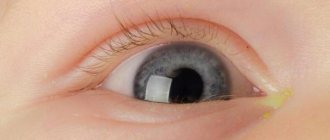Even when the child is in the womb, his parents try to guess who he will be like. And with the birth of the baby, not only mom and dad, but all relatives begin to compare the appearance and color of the baby’s eyes, arguing among themselves: “Mom’s nose!”, “But daddy’s eyes!”, forgetting that the baby’s facial features will change over time. . This especially applies to the color of the iris, which changes with age in most children. What exactly do such changes depend on? Why is this happening? When is the final color formed? We will tell you about all the features of eye color in this article.
The main factors influencing eye color
- Amount of pigment. All babies are born with gray-blue or greenish eyes, since there is no melanin pigment in the iris of a newborn. But gradually it accumulates, and the color of the baby’s eyes begins to change. The shade of the iris depends on the amount of this pigment substance: the more of it in the body, the darker the color. Melanin acts in the same way on human skin and hair.
- Nationality. Belonging to one's people is directly related to the color of one's skin, eyes and hair. For example, the vast majority of Europeans have gray, blue and light blue eyes, while Mongols and Turks have green, light brown and greenish-brown eyes. The Slavs have light blue and light gray eyes, the Negroid race has dark brown and black eyes. Of course, there are exceptions, but this is most likely the result of mixed marriages.
- Genetics. Related genes play a significant role in how a child will be born and who he will resemble. But you can’t rely 100% on genetics. If mom and dad have light eyes, then the likelihood that the baby will also have light eyes is 75%. If mom has light eyes and dad has dark eyes (and vice versa), then the baby will most likely have a dark color. If both parents have dark eyes, then the baby is unlikely to have a light color.
Treatment
The treatment tactics for anisocoria depend on its causes, which are determined during diagnosis. If the child does not have any diseases and his vision is not impaired, he is monitored, which includes periodic visits to an ophthalmologist.
Directions of therapy:
- imbalance in the work of the extraocular muscles, including in Horner's syndrome - myoneurostimulation of problem areas with current to improve their tone, surgical intervention in the presence of astigmatism;
- infectious diseases - use of immunostimulants, vitamins, antibiotics or antivirals;
- brain tumors, injuries, hemorrhages - surgical treatment;
- inflammatory eye pathologies - local and/or systemic antibiotic therapy;
- injuries of the cervical spine - massage, physiotherapy, and so on.
In parallel with the main treatment, the doctor may prescribe special drops that relieve spasm of the eye muscles. This helps normalize the functioning of the pupils.
Different pupil sizes in a child are a symptom that can be caused by various conditions. Most often, anisocoria is a congenital feature that goes away with age and does not affect vision. But the baby should be shown to an ophthalmologist
It is especially important to seek help if there are other pathological manifestations. Modern methods of therapy make it possible to correct the work of the extraocular muscles, but it is important to identify the underlying disease and treat it
When does a baby's eye color start to change?
From the moment a baby is born, his eye color remains a dull gray or greenish color for some time. But after six months, the shade of the iris begins to gradually change. And since changes occur slowly, the results are almost invisible to us. Due to melanin staining, a newborn’s eyes first darken, and by six months or one year of age they acquire the shade determined by genes. But this is not the final result. Melanin continues to accumulate and the color will take several years to form. It will become final by the age of 5-10 - this is individual for each child. In any case, the future color of the baby’s eyes can be judged no earlier than six months, and only at one year will it become clear what shade of eye color the child will have.
Age of formation of eye color in children
The process of changing the iris is very individual. Each baby develops at its own speed.
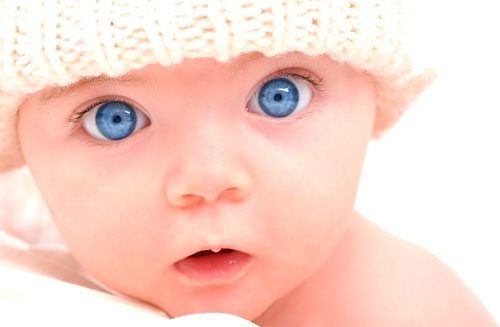
This is influenced by various factors:
- Health - any disease will slow down development processes.
- Is the baby full-term or born prematurely?
- Was he born mature?
- Heredity.
- Nutrition.
- Psychological environment, comfort.
- Having a mother nearby during the first years of development.
Many people underestimate the importance of a mother in the life of a newborn. Psychological tests have proven that children who are separated from their mother at an early age, even for a few months, will feel more lonely than other children in adulthood.
When the mother is absent for a long time, and the child is not held as often as he needs, he will grow up as a person who does not know how to show his emotions, who does not know how to love and show tenderness.
The first year of life is a psychological period of pregnancy. The child should stay with the mother as long as possible, be held in her arms.
Important! If a baby is rarely picked up, his psyche will be forever damaged. This will affect all processes in his body, including the production of melanin.
The true shade begins to appear at one year of age, and full formation occurs between the ages of one and a half to four years.

The formation of the internal processes of a newborn’s body is also influenced by the characteristics of his birth.
Today, babies are often diagnosed at birth:
- Jaundice.
- Open oval window in the heart.
- Cephalohematoma.
- Impaired reflexes.
- Umbilical hernia.
- Immaturity of internal organs.
- Ischemia.
Ischemia resolves by the age of one year, and the patent foramen ovale closes by the age of two years.
Jaundice is not dangerous, but it is harmful to the body and can significantly affect the course of all processes of the body; it is best treated in a hospital.
Treatment includes lying under an ultraviolet lamp and intravenous glucose.
These and any other congenital diseases should be monitored by a doctor. They do not pose a danger to life, but can affect the speed of development of the baby.
Can eye color remain the same or change?
- Grey. This color occurs quite often at the birth of a child and can vary from a light tone to a dark shade. Most often, babies with gray eyes appear among northeastern peoples. This color is typical for calm and slow children.
- Blue. The beautiful heavenly shade can also either lighten or darken over time, especially if the baby is fair-haired and fair-skinned. Children with blue eyes are dreamers, they are not capricious, prone to sentimentality and even pragmatic.
- Blue. This color is often found among northern peoples; the blue tint is formed as a result of a large amount of pigment that has already been produced in the body. Kids with blue eyes are vulnerable, touchy and emotional.
- Green. Children with green irises are born only to parents with light eyes. According to statistics, residents of Iceland and Turkey have the most green-eyed children. These kids are very demanding, persistent and stubborn - real leaders!
- Brown. If a baby is genetically programmed to have brown eyes, he will be born with a dark gray iris, which will change its shade to a brown tone closer to six months. Such children are distinguished by excessive activity, a cheerful disposition, shyness and hard work.
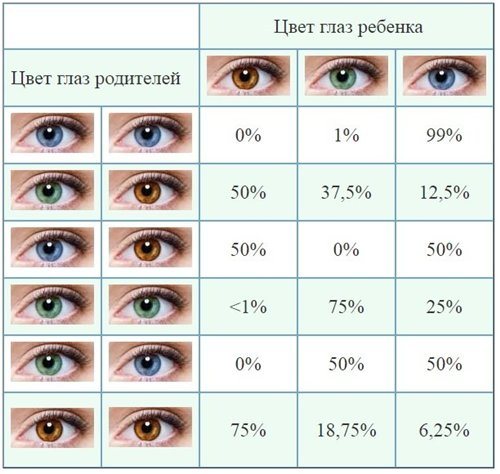
How to determine the final eye color of babies?
To determine the final eye color of the baby, genetic scientists have compiled a table, but its calculations are quite arbitrary. There is always a chance that the genes of some great-grandmother will manifest themselves - it’s rare, but it still happens. Therefore, this table should not be considered as the ultimate truth; it just clearly shows how genetic predisposition can affect the eye color of a little person.
Video about child's eye color
In what cases can there be eyes of different colors?
Very rarely there are pathologies of eye color that distinguish us from other people. They appear from birth and are visible almost immediately.
- Albinism. In this case, we are talking about the complete absence of the melanin pigment, as a result of which the eyes acquire a red tint. The main reason lies in the fact that the vessels of the iris are visualized. This pathology is very rare in humans.
- Aniridia. This is also a congenital anomaly, which is characterized by the absence of the iris, complete or partial, which directly affects vision. In most cases, this is inherited, and visual acuity is quite low.
- Heterochromia. Another hereditary pathology is when the eyes are of different colors. A child may have one eye brown and the other gray or blue. But there may be other options. This mutation does not affect vision or other functions in any way.
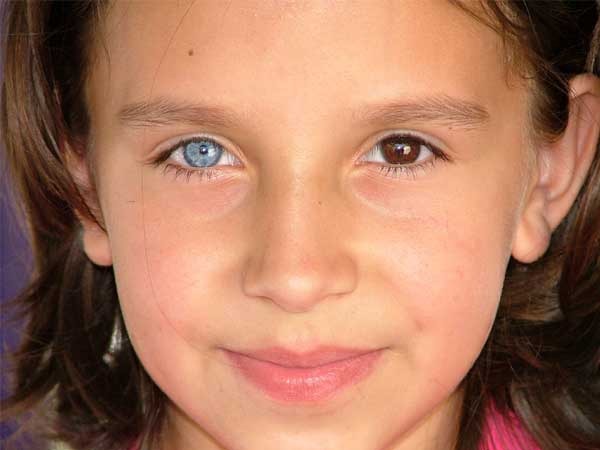
Why is this happening?
The fact is that eye color depends on a certain pigment – melanin. Both skin color and hair color depend on it.
This pigment is produced under the influence of light. There is practically no light inside the mother's womb, and therefore there is very little melanin. That's why most babies are born with blue eyes.
The amount of melanin in the baby’s intrauterine life depends only on the genetically determined level, which is determined by the skin color of the parents, belonging to a certain race (dark-skinned parents and children will have a high level of melanin, which means they may be born with brown eyes).
The complete absence of melanin is albinism, then the skin has a pinkish tint and the eyes are red, since their color is determined by the blood vessels that are visible through the skin or from the fundus of the eye, and the hair and eyelashes are completely white.
Albinism is very rare among people; much more often we can observe it in animals - for example, white rats with red eyes, which I think every person has seen at least once in their life.
Do diseases affect changes in eye color?
Previously, it was believed that if the shade of the iris changed, this certainly indicated that a person had some kind of disease. But research has refuted this theory. However, there are diseases that actually change eye color.
- Wilson-Konovalov disease. This disease can be diagnosed in young children and is a metabolic disorder that affects the nervous system. As a result, the ring around the iris of the eye becomes pronounced and distinct.
- Diabetes. Eye color can change only if the disease is severe - the iris becomes red-pink. The reason is the formation of blood vessels that appear during the disease. But this does not affect visual acuity in any way.
- Melanoma. Any tumor provokes changes in the body, and eye color is no exception. If this disease is diagnosed, the eye color may change to a darker shade. For example, blue eyes can become almost blue.
- Anemia. When the body lacks iron, it affects many organs. It often happens that the eye color becomes a shade (or even two) lighter. For example, blue eyes can turn blue, and black eyes can change to a brown tone.
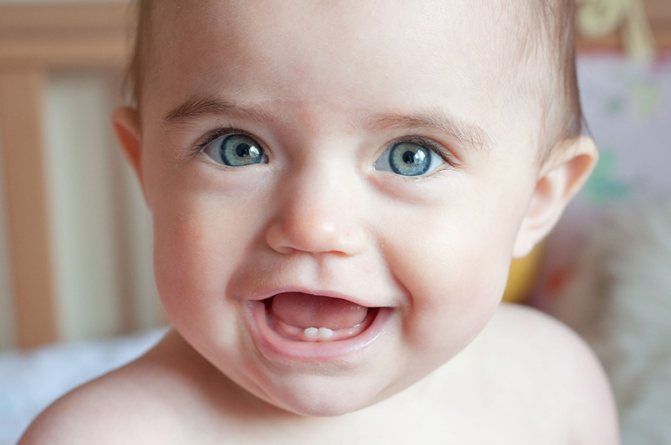
Does eye color affect visual acuity?
It is unknown where these assumptions came from, but for some reason many people believe that eye color is directly related to vision. Does the color of the iris really have any effect on dioptres? No evidence has been found for this. Any baby sees much weaker than an adult - this is explained by the fact that not all the organs of a newborn are sufficiently formed. Moreover: in the very first days of his life, the baby does not see anything at all, he only reacts to light. And only by a month or two or three he can already distinguish objects by 50%, after which his vision gradually becomes sharper.
Until what age can babies change color?
Many parents notice that the color of their baby's eyes often changes. A hungry child looks at his mother with green eyes, while an upset child looks at his mother with gray eyes.

A cheerful baby surprises with a bright iris. This is normal and often occurs in adults.
What is happening is explained by changes in the level of melanin under the influence of internal processes of the body.
Most babies are determined by the shade of their iris by the age of one and a half years. The timing of final determination may be delayed by two, three or five years.
Under the influence of melanin, the color intensifies and becomes more saturated. Blue-eyed children may remain blue-eyed, the shade will change, the iris will acquire a unique pattern. Changes will occur throughout your life.
Interesting fact! With age, melanin ceases to be produced. This happens individually, depending on hereditary factors. If a father turns gray early, the same will happen to his son. The color of the eyes will also become less saturated and fade.
Parents often associate the shade of their baby's iris with his character. There is no scientific evidence for this.
Skin, hair or eye color has nothing to do with personality. Blue-eyed people can be both kind and friendly and ardent sociopaths. This applies to all other colors as well.
Whatever the newborn’s eyes are, more attention should be paid to his needs. The age of color formation does not affect development; it is individual for everyone.
When melanin production processes fail, even children with different eyes can be found. The color may even out with age or remain that way.
Useful video
Share this post
- Related Posts
- Types and methods of swaddling a newborn baby
- The child does not listen: advice from a psychologist by year
- Etiquette for school children
- What to buy for a newborn baby: list of things
- Reasons why your child doesn't sleep well at night
- How to properly wash a newborn under the tap: a boy and a girl?
What else affects the color of a baby’s iris?
Don’t be alarmed if you suddenly notice that the color of your baby’s eyes has become lighter or darker. Babies, like adults, react to external stimuli, which affects the shade of their iris. For example, if the baby’s gray eyes have brightened, this indicates that the child may be reacting this way to the weather (for example, bright sun or rain). If the color of the eyes has darkened, then it is possible that the baby is in pain. It also happens that the shade of a baby’s iris can become almost transparent - do not be alarmed by this. Your baby is simply calm, peaceful and in a relaxed state.
